Abstract
Cultures for mycoplasmatales, viruses and bacteria were made from bovine vulvar swabs to determine whether ureaplasma was associated with a clinical granular vulvitis observed in 16 Ontario dairy herds. Ureaplasma was isolated from 23.5% of 34 clinically normal cows, 74% of 27 cows with mild to moderate vulvar hyperemia but no discharge and 100% of 20 cows with acute vulvar hyperemia accompanied by purulent discharge. There were statistically significant differences in rates of isolation among clinical groups. Mycoplasma bovigenitalium was isolated from 7.7% and 20% of cows with moderate or acute vulvitis respectively but not from normal cows. Haemophilus somnus was isolated from 25% of cows with acute vulvitis. There were no significant differences in isolations of Escherichia coli, Corynebacterium pyogenes and alpha-hemolytic streptococcus between normal and clinically affected animals. Cultures of 135 repeat samples from 33 cows revealed that ureaplasma persisted in some animals for at least three months. No viruses were isolated from any of the animals in this study.
Full text
PDF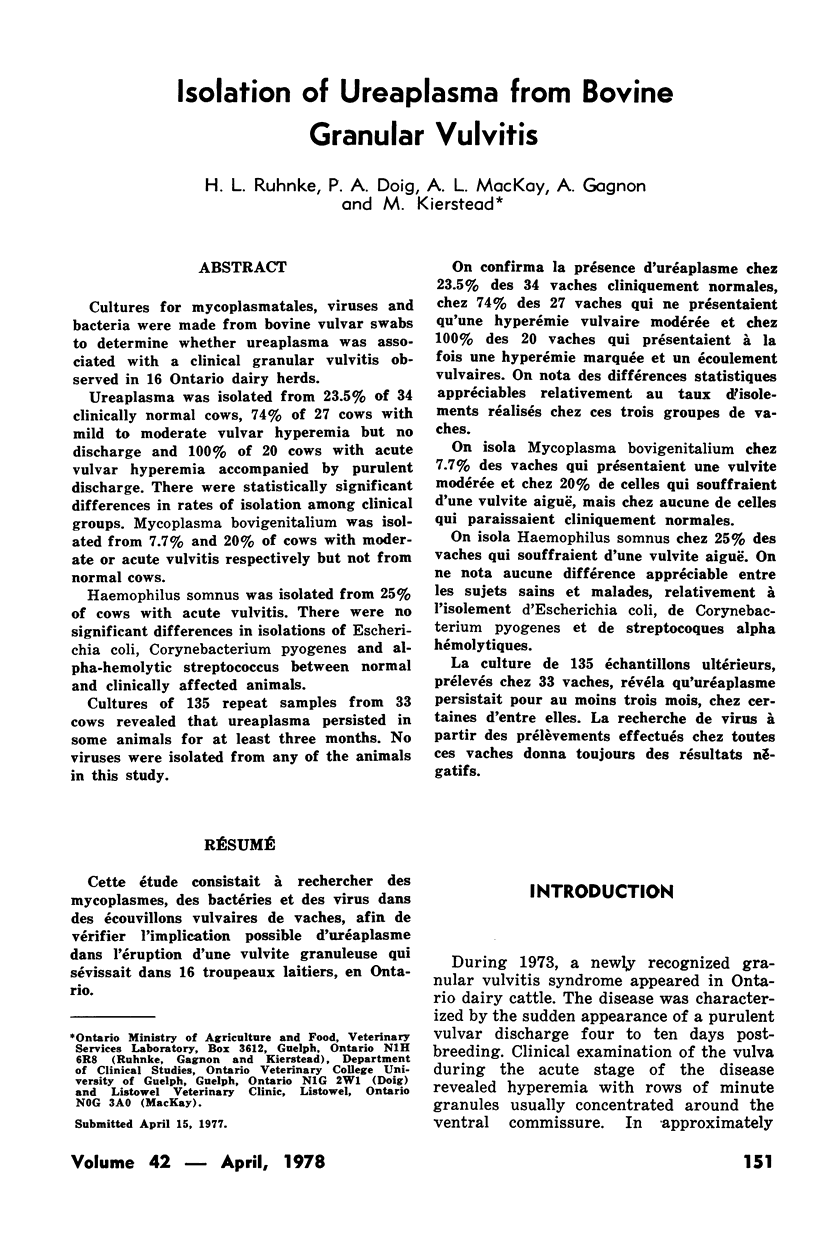
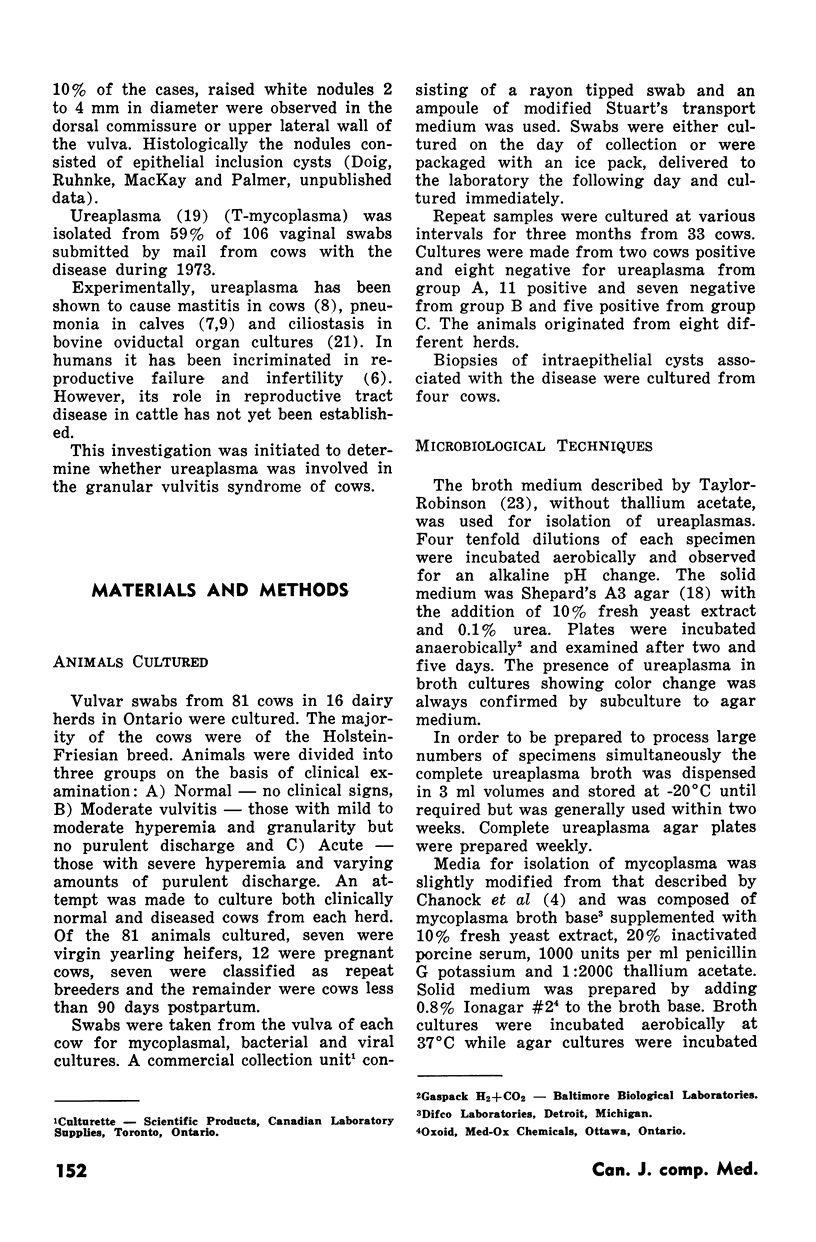
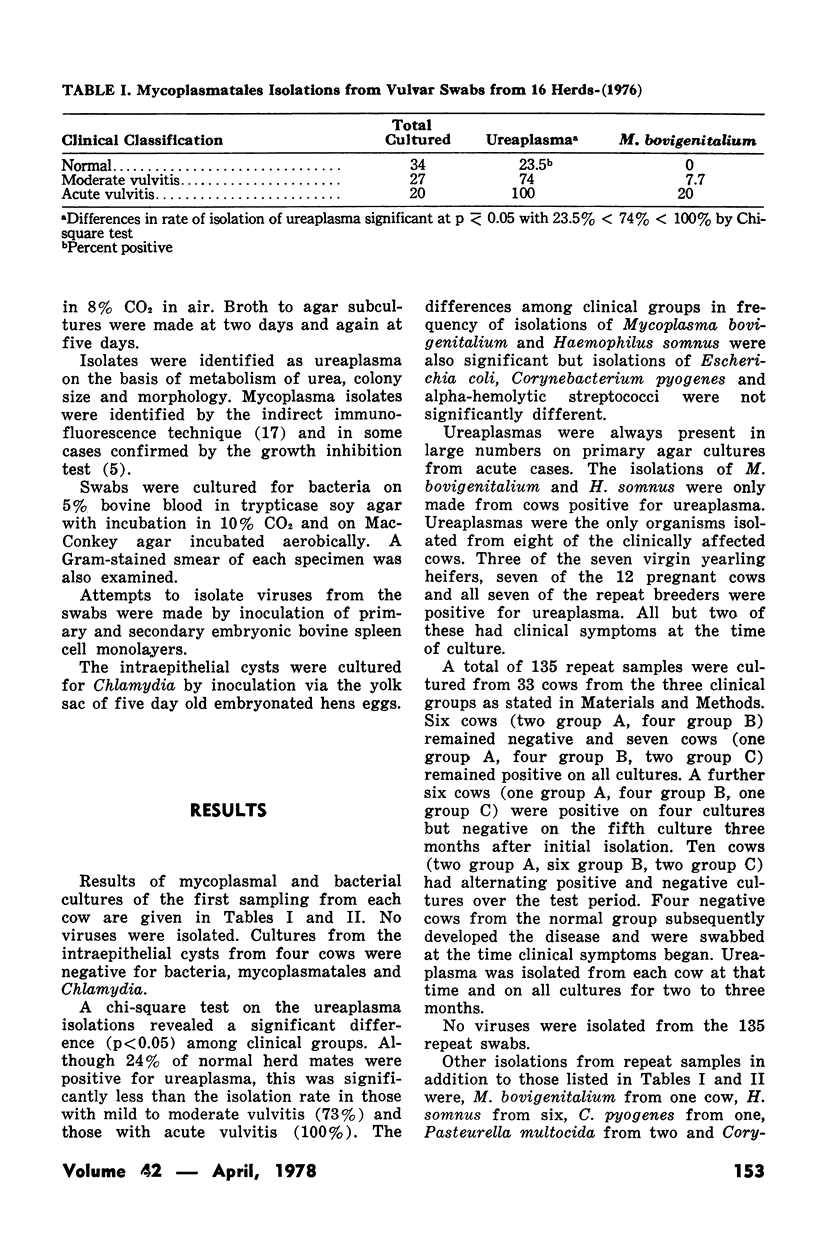
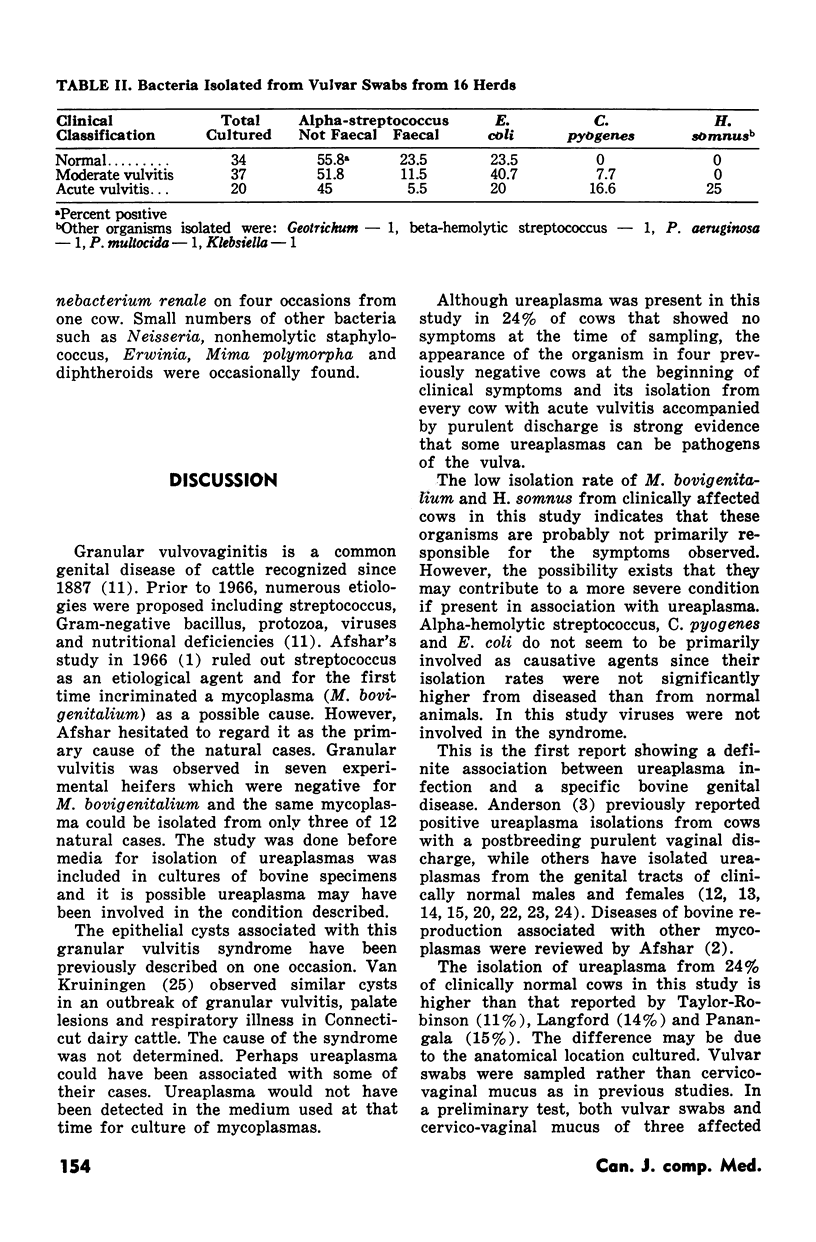
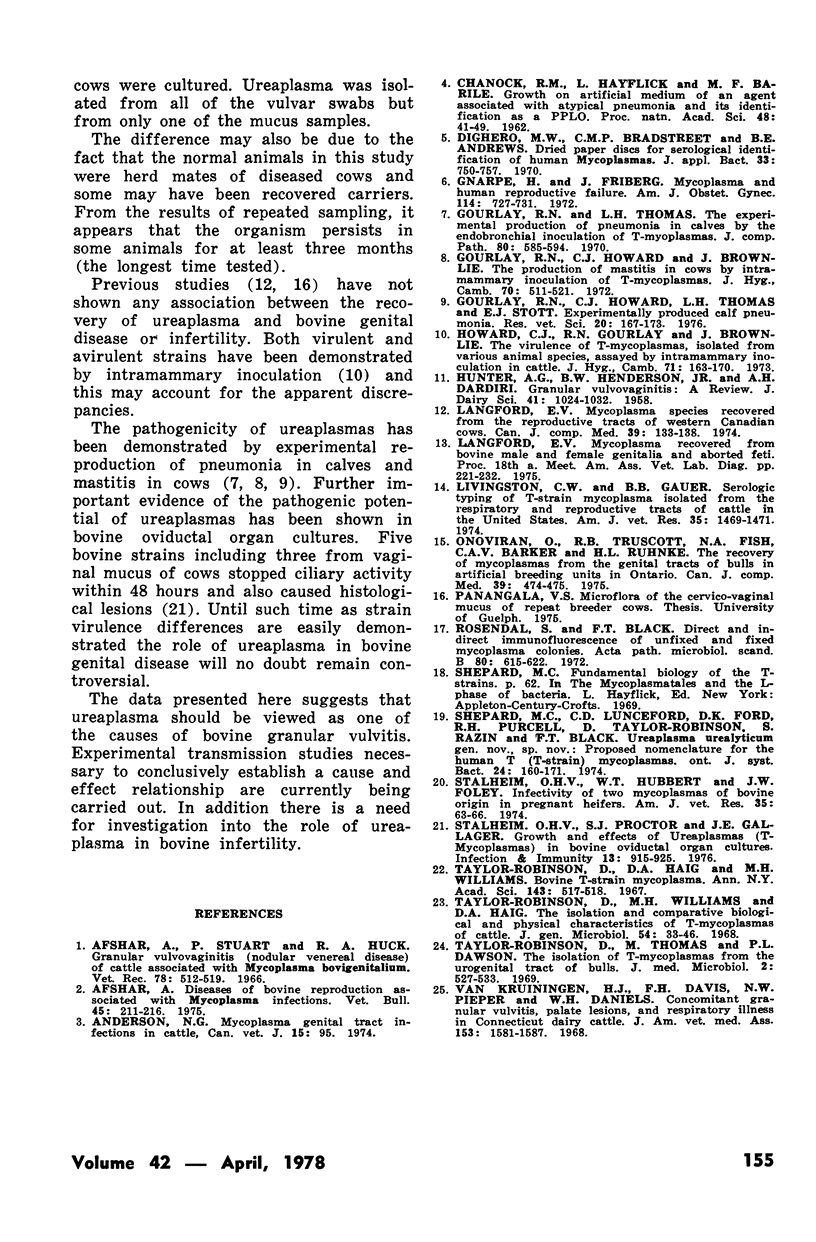
Selected References
These references are in PubMed. This may not be the complete list of references from this article.
- Afshar A., Stuart P., Huck R. A. Granular vulvovaginitis (nodular venereal disease) of cattle associated with Mycoplasma bovigenitalium. Vet Rec. 1966 Apr 9;78(15):512–518. doi: 10.1136/vr.78.15.512. [DOI] [PubMed] [Google Scholar]
- Anderson N. G. Mycoplasma genital tract infections in cattle. Can Vet J. 1974 Mar;15(3):95–95. [PMC free article] [PubMed] [Google Scholar]
- CHANOCK R. M., HAYFLICK L., BARILE M. F. Growth on artificial medium of an agent associated with atypical pneumonia and its identification as a PPLO. Proc Natl Acad Sci U S A. 1962 Jan 15;48:41–49. doi: 10.1073/pnas.48.1.41. [DOI] [PMC free article] [PubMed] [Google Scholar]
- Dighero M. W., Bradstreet C. M., Andrews B. E. Dried paper discs for serological identification of human mycoplasmas. J Appl Bacteriol. 1970 Dec;33(4):750–757. doi: 10.1111/j.1365-2672.1970.tb02259.x. [DOI] [PubMed] [Google Scholar]
- Gnarpe H., Friberg J. Mycoplasma and human reproductive failure. I. The occurrence of different Mycoplasmas in couples with reproductive failure. Am J Obstet Gynecol. 1972 Nov 15;114(6):727–731. [PubMed] [Google Scholar]
- Gourlay R. N., Howard C. J., Brownlie J. The production of mastitis in cows by the intramammary inoculation of T-mycoplasmas. J Hyg (Lond) 1972 Sep;70(3):511–521. doi: 10.1017/s0022172400063099. [DOI] [PMC free article] [PubMed] [Google Scholar]
- Gourlay R. N., Howard C. J., Thomas L. H., Stott E. J. Experimentally produced calf pneumonia. Res Vet Sci. 1976 Mar;20(2):167–173. [PubMed] [Google Scholar]
- Gourlay R. N., Thomas L. H. The experimental production of pneumonia in calves by the endobronchial inoculation of T-mycoplasmas. J Comp Pathol. 1970 Oct;80(4):585–594. doi: 10.1016/0021-9975(70)90056-3. [DOI] [PubMed] [Google Scholar]
- Howard C. J., Gourlay R. N., Brownlie J. The virulence of T-mycoplasmas, isolated from various animal species, assayed by intramammary inoculation in cattle. J Hyg (Lond) 1973 Mar;71(1):163–170. doi: 10.1017/s0022172400046337. [DOI] [PMC free article] [PubMed] [Google Scholar]
- Langford E. V. Mycoplasma species recovered from the reproductive tracts of western Canadian cows. Can J Comp Med. 1975 Apr;39(2):133–138. [PMC free article] [PubMed] [Google Scholar]
- Livingston C. W., Jr, Gauer B. B. Serologic typing of T-strain mycoplasma isolated from the respiratory and reproductive tracts of cattle in the United States. Am J Vet Res. 1974 Nov;35(11):1469–1471. [PubMed] [Google Scholar]
- Onoviran O., Truscott R. B., Fish N. A., Barker C. A., Ruhnke H. L. The recovery of Mycoplasmas from the genital tracts of bulls in artificial breeding units in Ontarïo. Can J Comp Med. 1975 Oct;39(4):474–475. [PMC free article] [PubMed] [Google Scholar]
- Rosendal S., Black F. T. Direct and indirect immunofluorescence of unfixed and fixed Mycoplasma colonies. Acta Pathol Microbiol Scand B Microbiol Immunol. 1972;80(4):615–622. doi: 10.1111/j.1699-0463.1972.tb00186.x. [DOI] [PubMed] [Google Scholar]
- Stalheim O. H., Hubbert W. T., Foley J. W. Infectivity of two mycoplasmas of bovine origin in pregnant heifers. Am J Vet Res. 1974 Jan;35(1):63–66. [PubMed] [Google Scholar]
- Stalheim O. H., Proctor S. J., Gallagher J. E. Growth and effects of ureaplasmas (T mycoplasmas) in bovine oviductal organ cultures. Infect Immun. 1976 Mar;13(3):915–925. doi: 10.1128/iai.13.3.915-925.1976. [DOI] [PMC free article] [PubMed] [Google Scholar]
- Taylor-Robinson D., Haig D. A., Williams M. H. Bovine T-strain mycoplasma. Ann N Y Acad Sci. 1967 Jul 28;143(1):517–518. doi: 10.1111/j.1749-6632.1967.tb27697.x. [DOI] [PubMed] [Google Scholar]
- Taylor-Robinson D., Thomas M., Dawson P. L. The isolation of T-mycoplasmas from the urogenital tract of bulls. J Med Microbiol. 1969 Nov 4;2(4):527–533. doi: 10.1099/00222615-2-4-527. [DOI] [PubMed] [Google Scholar]
- Taylor-Robinson D., Williams M. H., Haig D. A. The isolation and comparative biological and physical characteristics of T-mycoplasmas of cattle. J Gen Microbiol. 1968 Nov;54(1):33–46. doi: 10.1099/00221287-54-1-33. [DOI] [PubMed] [Google Scholar]
- Van Kruiningen H. J., Davis F. H., Pieper N. W., Daniels W. H. Concomitant granular vulvitis, palate lesions, and respiratory illness in Connecticut dairy cattle. J Am Vet Med Assoc. 1968 Dec 15;153(12):1583–1587. [PubMed] [Google Scholar]


